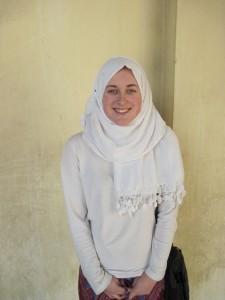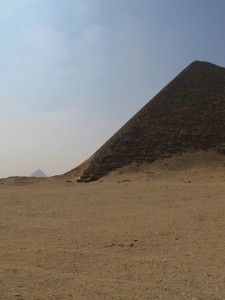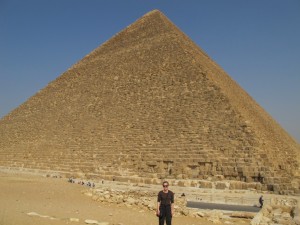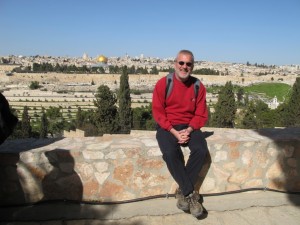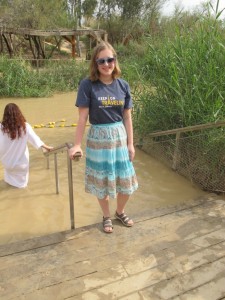Another full day of engaging Egyptian sights greeted our hardy crew on day 3 of Imprint’s Egypt/Jordan tour. We loaded up our bus, introduced ourselves to our Egyptian security guard, and headed south for Dashure. The Egyptian government, eager to protect their struggling tourism sector, has given us an armed guard and 2 following policemen in a car each day. We drove about an hour south and east of central Cairo to visit the Bent and Red Pyramids.
 I honestly believe we had a superior experience today. For starters, there were virtually no other tourists at Dashure and absolutely no venders or touts. We had the site to ourselves. The Bent Pyramid is famous for having two angles to each of its four sides. Begun years before the great pyramids of Giza, Egyptian engineers had yet to work out the exact optimum angle – which turned out to be 43 degrees. They started building at 54 degrees. But once the sides got to about 80 feet high cracks began to appear. They did more engineering and worked out the correct 43 degree angle and the top 1/3 of the structure is built to that angle. About a mile away is the Red Pyramid, so called due to the redish sandstone from which it is built.
I honestly believe we had a superior experience today. For starters, there were virtually no other tourists at Dashure and absolutely no venders or touts. We had the site to ourselves. The Bent Pyramid is famous for having two angles to each of its four sides. Begun years before the great pyramids of Giza, Egyptian engineers had yet to work out the exact optimum angle – which turned out to be 43 degrees. They started building at 54 degrees. But once the sides got to about 80 feet high cracks began to appear. They did more engineering and worked out the correct 43 degree angle and the top 1/3 of the structure is built to that angle. About a mile away is the Red Pyramid, so called due to the redish sandstone from which it is built.
We were also able to climb a small, crumbling pyramid next to the bent one. Fun photos followed. More fun was had when most of the group opted to go inside the red one. Hoda warned us the passage down was long and short, but fully ¾ of the group braved the ordeal. And it was an ordeal. I’ve heard many complaints of sore leg muscles since. I was proud that Imprint attracts such intrepid travelers. There was really nothing to see inside. The value of entering is what I like to call the proximity factor of travel – the value was just to say you had gone into a pyramid. And for that, it was awesome! Everyone was on a high after the Dashure visit.
Another great lunch that featured small braziers of grilled meats brought to the table preceded our plunge into the urban jungle of Islamic Cairo.  We started with a mosque visit where Hoda helped all the women in the group cover their heads with a hijab. Then she explained the basics of Islam and how a mosque is generally used. That lesson made quite an impression on Maia and she has written about it in her blogs. Next Hoda guided us through a merchant house to understand the secular side of old Cairo. Then it was on to the highlight of the afternoon, the famous Khan el Khalili bazaar, the Middle East’s largest public market.
We started with a mosque visit where Hoda helped all the women in the group cover their heads with a hijab. Then she explained the basics of Islam and how a mosque is generally used. That lesson made quite an impression on Maia and she has written about it in her blogs. Next Hoda guided us through a merchant house to understand the secular side of old Cairo. Then it was on to the highlight of the afternoon, the famous Khan el Khalili bazaar, the Middle East’s largest public market.  There are still blocks and blocks devoted to silks and fabrics, gold, or spices, but we honed in on the section that has given over to tourism. Probably 4-5 blocks of parallel streets connected by narrow alleys – all groaning with shiny tourist trinkets. Good fun! The group settled into sidewalk tables for mint tea or fresh fruit juice at storied Feshawi’s Café.
There are still blocks and blocks devoted to silks and fabrics, gold, or spices, but we honed in on the section that has given over to tourism. Probably 4-5 blocks of parallel streets connected by narrow alleys – all groaning with shiny tourist trinkets. Good fun! The group settled into sidewalk tables for mint tea or fresh fruit juice at storied Feshawi’s Café.  While we relaxed in the old world ambiance the old world came to us. Hawkers and street peddlers stopped to sell watches, jewelry, papyrus, stuffed camels, bread, bobble-head dogs, perfume bottles and more I can’t recall. For those seated on the edge, it was a clear irritant as the stream was uninterrupted and frequently repetitive. But for those away from the narrow passage, it was more like a show. Khalili is one of those in-your-face experiences that either fills you with amusement or dread.
While we relaxed in the old world ambiance the old world came to us. Hawkers and street peddlers stopped to sell watches, jewelry, papyrus, stuffed camels, bread, bobble-head dogs, perfume bottles and more I can’t recall. For those seated on the edge, it was a clear irritant as the stream was uninterrupted and frequently repetitive. But for those away from the narrow passage, it was more like a show. Khalili is one of those in-your-face experiences that either fills you with amusement or dread.
After tea Maia and I plunged in for some shopping. She has friends she’d like to find some souvenirs for. We had to smile at the various “hook’ lines. I don’t know what you’re looking for but I’ve got it. Let me take your money. Welcome, looking is free. Just a million dollars. And so on . . . . We were successful in procuring some fun gifty trinkets, including a pyramid snow globe to add to Maia’s collection. The first price for everything was $100. We ended up paying $15 – and I’m sure I could have gotten it for less. But Egypt is struggling and the tourist sector is one of the hardest hit. I enjoy the bargaining but I’m willing to leave a few bucks on the table these days.
Our dinner was at Cairo’s premier view restaurant, atop Azher park. We dined on the terrace with a view over the minarets and domes of Islamic Cairo. The illuminated Citadel and its towering mosque dominated the vista. The buzz was still about the interior of the Red Pyramid and the intensity of Khan el Khalili. Another good day.
